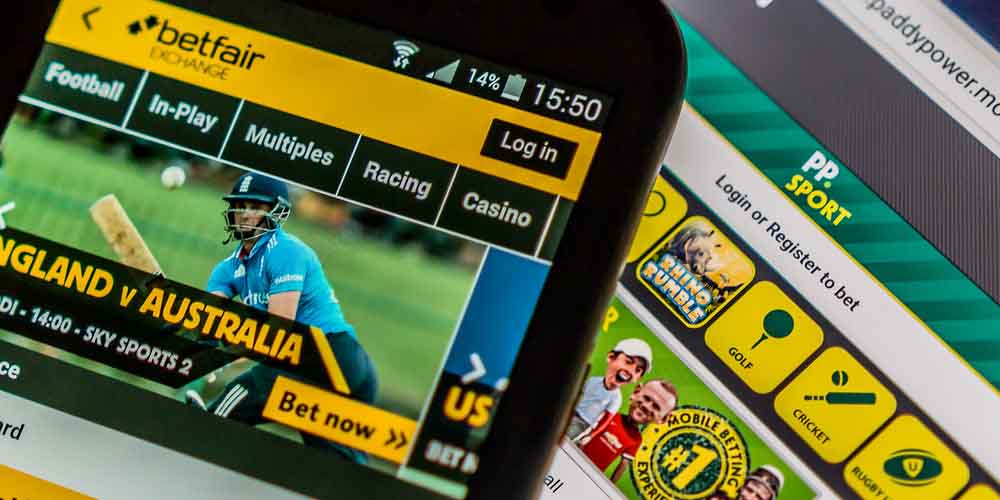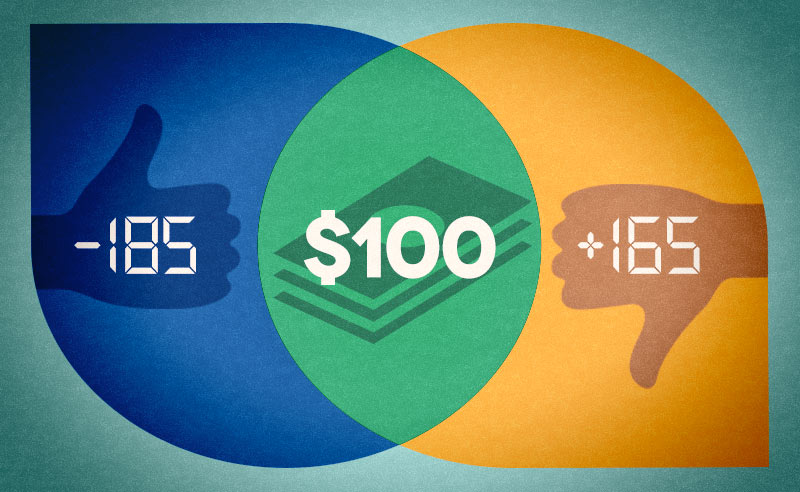Moneyline Odds
- Where to Bet:
The easiest way to understand moneyline wagers is by using a $100 bet. Using the above example, the moneyline on the underdog Buccaneers opened at +148 (currently +150). At +148 odds, a $100 wager would pay $148 in profit if the Buccaneers won the game (for a total payout of $248). A moneyline bet is a straightforward wager on which team will win a particular game. The odds compilers at sports betting sites will weigh up the relative strengths and weaknesses of each team.
How to bet NFL Las Vegas Money Line Odds
If your team wins, you win!
A NFL money line wager means you’re simply picking a side. The betting term Against the Spread (ATS) is not necessary for these types of wagers since the spread is not a factor.
Similar to our Spread and 1st Half Odds, every matchup is listed in order of Rotation and those numbers are preceded by the Date and Time of the NFL game, every matchup is listed in order of Rotation and those numbers are preceded by the Date and Time of the NFL game.
The Rotation for NFL games typically lists them by scheduled starting time as there are normally no more than three games in a day. Home teams are listed at the bottom and will therefore be your even-numbered squad.
The numbers next to the teams are based on a scale where $100 is the key figure. Favorites are the teams with the minus (-) sign next to their figure, which represents what it would take to win yourself $100 with the favored group. The team in the Underdog role has the plus (+) symbol next to the amount you would be able to win by wagering $100.
How to read NFL Las Vegas Money Line Odds
In this example, the Cleveland Browns were listed as a 5.5-point favorite against the Tennessee Titans. Looking at this from a money-line standpoint, Cleveland is a -245 favorite to win the game straight-up, compared to Tennessee at +210 to win the contest.

Cleveland -245 (Bet $100 to win $40.80)
Tennessee +210 (Bet $100 to win $210)
That number is set by oddsmakers after the spread is established but changes throughout the week based on the amount of money coming in on bets.
In this contest, Tennessee actually upset Cleveland, 43-13 in easy fashion to cash at +210 Money Line Odds. If you bet $100 on Tennessee to win the game outright, you receive the $210 for the winning ticket, plus getting back the $100 you placed on the game for a $310 victory.
However, going for it all by taking underdogs on the Money Line instead of taking the points turns out to be a tough pill to swallow.
In the 2019 season opener, Philadelphia closed as a hefty 10-point home favorite against Washington. The Eagles were -500 on the Money Line, while Washington was a juicy +425 to pull the road upset.
Philadelphia -500 (Bet $500 to win $100, Betting $100 wins only $20)
Washington +425 (Bet $100 to win $425)
Washington actually led this game, 20-7 at halftime, but was outscored, 25-7 in the second half to lose to Philadelphia, 32-27. If you took the points with Washington, you were a winner. However, if you backed Washington on the Money Line, you walk away with nothing as it lost the game straight-up.
The VegasInsider.com Parlay Calculator is a great tool to see what kind of return you can create while avoiding the pitfalls of risk. Just avoid the upset.
Money lines (also called American Odds) are one of the most common ways to bet on sports. They do not use a point spread, and are straight-up bets on who will win the game or event.
To properly explain how to bet the money line, the first thing to understand is the difference between a negative and positive money line. Both money lines use $100 as the basis point for calculating payouts, but they’re calculated differently.
How to Calculate Money Line Payouts
A negative money line is indicated with a ‘-‘ in front of a number, like -230. The number represents the amount of money that would need to be wagered in order to win $100 in profit. So, a -230 money line would require a wager of $230 to win $100 more, for a total payout of $330 ($230 wager + $100 profit). Of course a $230 bet is not required, it’s just the basis for calculating the payout. With odds of -230, a $23 bet would return $10 in profit, or a $2.30 bet would return $1 in profit.
A positive money line is indicated with a ‘+’ in front of a number. In this case, the number represents the amount that would be won from a $100 wager. So, a +170 money line means that a $100 wager would return $170 in profit, for a total payout of $270 ($100 wager + $170 profit = $270). A bet of $10 would result in a $17 profit, and a total payout of $27 ($10 wager + $17 profit = $27).
More About Negative Lines
Generally a negative money line represents the favored team in a match. There are exceptions to this and we’ll discuss that later. For now, think negative money line = favorite.
In most two-team games like football, baseball or soccer, one team will have a negative money line, and the opponent will have a positive money line. The team with a negative money line is the favorite, and the team with the positive money line is the underdog.
Example:
- New England Patriots +140
- Indianapolis Colts -160
In this case, the Colts are the favorite. It would take a bet of $16 to win $10 in profit, for a total payout of $26 ($16 wagered + $10 profit = $26). For the Patriots, as the underdog, it would only take a bet of $10 to win $14 in profit, for a total payout of $24 ($10 wager + $14 profit = $24).
Since the favored team is considered more likely to win, and because no handicap is being used, it takes a larger wager to win a smaller profit on them.
More About Positive Lines
In a 2-team game where one team has a positive money line, they are always the underdog. Since they’re underdogs, it requires a smaller wager to win a larger profit.
Example:
- Pittsburgh Penguins +130
- New York Rangers -150
In this case, a bet of $10 on the Penguins would result in a $13 profit if they win, for a total payout of $23 ($10 wager + $13 profit = $23). For the Rangers, it would take a bet of $15 to win $10 in profit, for a $25 total payout ($15 wager + $10 profit = $25).
Games Where Both Teams Are Negative
In games like baseball or football, it’s not uncommon to see both teams represented with a negative money line. When this happens, it means the teams are very closely matched.
Moneyline Odds Chart
For Example:
- New York Yankees -113
- Boston Red Sox -107

In the scenario above, the game is considered very close, with a slight edge towards the Yankees. It would require a bet of $113 to win $100 on the Yankees, or $107 bet to win $100 on the Red Sox.

Sports With Multiple Teams or Competitors
Of course there are sports with multiple competitors in a single event, like horse racing, Olympic events, and golf. This is also the case in futures bets, where the handicapper is choosing between multiple teams to win a seasonal champion.
In this case, there will generally be one favorite, indicated with a negative money line, and the rest of the field will have positive money lines. Sometimes, when there are no clear favorites, there may not be a single competitor with a negative money line. In this case, the competitor with the lowest positive money line is favored.
Example:
Tiger Woods +600
Phil Mickelson +850
Martin Kaymer +1300
Lee Westwood +1600
Steve Stricker +2300
In this case, Tiger Woods is the favorite, but he has a positive money line. A bet of $10 on him would result in a $60 profit if he wins. A bet of $10 on Steve Stricker would result in a $230 profit if he were to win.
Converting Moneyline Odds to Fractional Odds
We all learned how to do fractions in elementary school, and once you understand money line odds, the conversions are simple.
How to Convert Positive Money Lines to Fractional Odds
To convert a positive money line into fractional odds, divide the number in the money line by 100.
Examples:
- +250 Money Line: 250/100 = 2.5/1 (5/2) Fractional Odds
- +400 Money Line: 400/100 = 4/1 Fractional Odds
- +650 Money Line: 650/100 = 6.5/1 (13/2) Fractional Odds

How to Convert Negative Lines to Fractional Odds
To convert negative money lines to fractional odds, divide the number in the money line by 100. Put that number on the right side of a fraction which begins with ‘1/’. Some numbers on the right side of the fraction will have a decimal in them. Since decimals are not used in fractional odds, they are removed by multiplying both numbers in the fraction by 2.
Examples:
- -200 Money Line: 200/100 = 2. Put the 2 on the right side of a fraction beginning with 1/, resulting in fractional odds of 1/2.
- -350 Money Line: 350/100 = 3.5. Put the 3.5 on the right side of a fraction beginning with 1/, resulting in fractional odds of 1/3.5. Multiply both numbers in the fraction by 2 to remove the decimal = 2/7 fractional odds.
- -650 Money Line: 650/100 = 6.5. Put the 6.5 on the right side of a fraction beginning with 1/, resulting in fractional odds of 1/6.5. Multiply both numbers in the fraction by 2 to remove the decimal = 2/13 fractional odds.
Converting to Decimal Odds
Positive money lines show the profit that would be won from a $100 bet, not including the original wager. Negative money lines show the wager required to win $100 in profit. Neither of these reflect the total payout. This is different in decimal odds.
Using decimal odds, a handicapper can easily calculate their entire payout. For example, a team with decimal odds of 3.0 would be multiplied by the wager amount to calculate the entire payout. A $20 bet with 3.0 decimal odds would pay out a total of $60 ($20 x 3.0 = $60).
The calculation to convert a positive money line to decimal odds is different from the calculation of a negative money line to decimal odds. Here’s how they convert:
How to Convert a Positive Money Line to Decimal Odds
To convert a positive money line to decimal odds, divide the money line by 100, then add 1.
Examples:
- +200 / 100 = 2 + 1 = 3.0 Decimal Odds
- +350 /100 = 3.5 +1 = 4.5 Decimal Odds
- +625 / 100 = 6.25 +1 = 7.25 Decimal Odds
Negative Lines to Decimal Odds
To convert a negative money line to decimal odds, start with the number 100 and divide it by the number in the money line, then add 1.
Examples:
- -200 Money Line: 100 / 200 = .5 +1 = 1.5 Decimal Odds
- -350 Money Line: 100 / 350 = .286 +1 = 1.286 (1.29) Decimal Odds
- -625 Money Line: 100 / 625 = .16 +1 = 1.16 Decimal Odds
Pros & Cons of Money Line Bets
When compared to a point spread, for the underdog, the benefit of a money line bet is the increased odds a handicapper receives. For the favorite, the benefit is that no handicap is given to the underdog, making it more likely their bets will win.
For the underdog, the negative is that they don’t receive a handicap, making it more difficult to win these bets. For the favorite, the negative is that the punter receives lower odds than they do when they’re giving up points on the spread.
Moneyline Odds
Comparing the money line to the run line in baseball or puck line in hockey, the benefit ‘can’ be slightly reduced juice (vig, or commission). For example, many online sportsbooks charge a 5% vig on baseball or hockey money line bets. However, it’s harder to find reduced juice on run lines and puck lines, where punters normally pay 10% vig. Over the course of a season and a lot of bets, 5% can be the difference of being a winning or losing handicapper.
College Football Moneyline Odds
Money lines are the most popular way to bet on MLB baseball and NHL hockey, so the lines can move dramatically from the time they’re posted to the time they close. If you know how to watch lines move and predict where they’re going, money lines can offer a lot of value. For example, when betting on big underdogs in baseball, the best money line odds can often be found as soon as the lines open – before other bettors see the same value you do and bring the odds down. For big favorites, it’s often best to wait until 1-2 hours before game time. For big games with a lot of action, sharp bettors often place big wagers just before a game, which can also create optimal betting opportunities.

Moneyline Odds Converter
For casual bettors, money line bets are easier to make. There is no point spread to mull over, and all that matters is that you choose the winner.